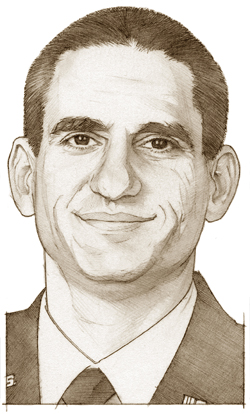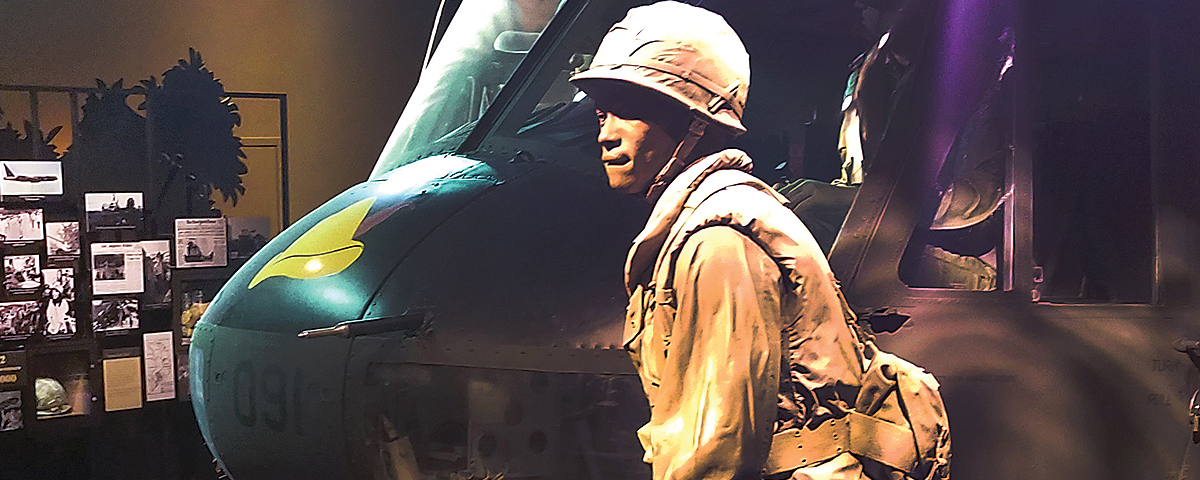
Frank A. Blazich Jr., curator for the Division of Armed Forces History at the National Museum of American History in Washington, D.C., and a past historian for the Naval History and Heritage Command and Civil Air Patrol, combines a passion for academic history with an abiding interest in cultural heritage and curation. He recently spoke with Military History about the importance of local museums and the evolving definition of what constitutes history.
Whom do you credit for your curating skills?
With no disrespect to Ohio State University, I would actually say my late father. In 1965 he was drafted into the Army during the buildup for the Vietnam War. Originally trained as a military policeman, his military specialty code was suddenly changed to infantry, and he was assigned to the famed 7th Cavalry Regiment. After four months in combat my dad took a bullet through the middle of his left hand and was medevaced out of Vietnam. He ended up losing part of his hand and being medically retired from the Army.
Dad always maintained a vigorous interest in military history. He collected a little bit of everything, predominantly American. There is a proliferation of reproductions and fakes—particularly with Civil War and Third Reich artifacts—and Dad got burned a few times on items he discovered were contemporary reproductions. He would frequently pull me in as his research assistant. Translation: I did all the research, because I knew how to use a computer. I’d learn the origins of an object by looking very closely at certain details, to see if it was original or if it was a fake.
For me, it’s about incorporating academic training as a historian with an eye toward curation, with an eye toward cultural heritage and public presentation. All of these skills came together in different ways, and by luck or fate I ended up here at the Smithsonian.
What spurred your interest in naval history?
Seventy-one percent of the world’s surface is covered by water. To really defeat your adversary, you have to physically control their space. I got interested in naval history growing up in North Carolina, because every year my family would visit the Outer Banks. Learning about the different shipwrecks off the coast, getting exposed to the sea…salt water just kind of started to enter into the bloodstream to some degree.
After graduate school, even though I did not study naval history, I had the luck to be hired by the U.S. Navy, and the interest—by default, to some extent—kind of blossomed.
Do you have a favorite item in the Smithsonian collection?
One fascinating piece is a U.S. Navy Mark 6 Mod 1 Exploder. The Mark 6 was developed in secrecy in the late 1920s. When installed on a U.S. Navy torpedo, it was designed to pass under the hull of an enemy warship and detonate just beneath the keel. Due to cost limitations they only tested it one time successfully in the interwar period, then boxed it up, put it on the shelf and waited for the next war.
Problem was, from 1942 into 1943 approximately two-thirds of our torpedoes failed to explode. However, once the exploder was improved, the Navy’s submarine community began devastating the Japanese navy and merchant fleet. To find out we have an exploder in the original storage crate here in the collection was really something.
What lessons should museum visitors take away?
Flippantly, I’d say, “Please give us your stuff.” We’re always interested in new acquisitions and new artifacts to help tell the story.
What we’ve tried to do in our exhibit “The Price of Freedom: Americans at War” is allow people to really understand how war and the military have shaped our nation—and continue to shape it. This country was forged in war, during the revolution, and many elements of our culture stem either from the military as an institution or from interactions between our civilian and military communities. While our exhibit can’t tell all aspects of America’s military heritage, we allow visitors to get exposed to the long arc of history.
At what point does an event pass into history?
Speaking personally, I believe history is constant—what happened an hour ago is history in the sense that it is the past. But at what point is something removed enough that we can provide a contextual understanding of it? That is a challenge for museums, not only because we may not have the objects, but also because how far does one want to step away to avoid, say, political controversy or position oneself to increase confusion rather than understanding?
You can certainly exhibit items pertaining to past stages of American military involvement, but we can’t really put a conclusion in an exhibit about the conflict in Iraq, for example, because we don’t have enough separation to accurately contextualize the true outcome of that particular conflict.
How has the U.S. POW experience changed over time?
There are a lot of commonalities. We don’t leave our men and women behind. Furthermore, particularly during the Vietnam War, we saw an advocacy for American POWs that was not generated within the military but by the families. That’s really unprecedented.
During the Korean War some men did not want to come back and stayed in North Korea. Because of that, a code of conduct was passed by executive order under President Dwight D. Eisenhower to curtail any potential prisoner issues in future conflicts. During the Vietnam War it was extraordinarily difficult for prisoners to adhere to that code—but most did, at great personal sacrifice, bereavement and misery.
Also, there is now a recognition of the wounds that are not visible, of the mental anguish that service members have endured. In World War I it was called shell shock, in World War II it was battle fatigue, and from Vietnam on it’s been known as post-traumatic stress. It’s not just a POW issue but an American veteran issue in general.
What’s on your short list of best history museums?
I have to be biased and say the National Museum of American History is my favorite museum, although I am partial to state history museums and smaller military museums. In my home state the North Carolina Museum of History has put together an incredible exhibit on World War I, focused on the experience in the trenches. I highly recommend it to anybody passing through Raleigh.
Nor should we ever bypass small community museums across the country. They all have unique, priceless treasures in them that have been selected by the communities, to say, This is who we are. This is where our past originates. MH





